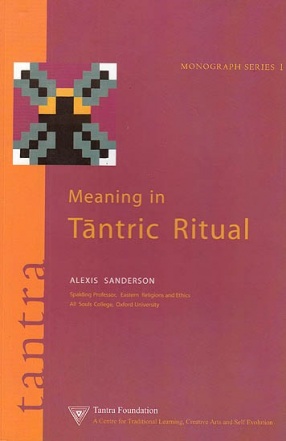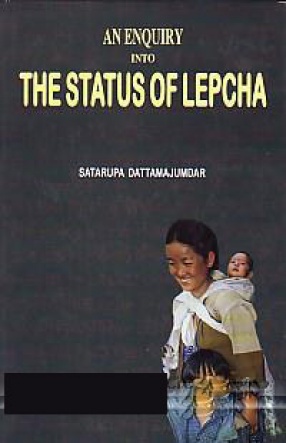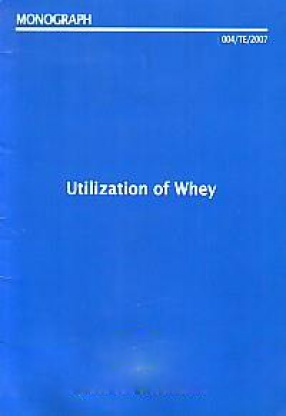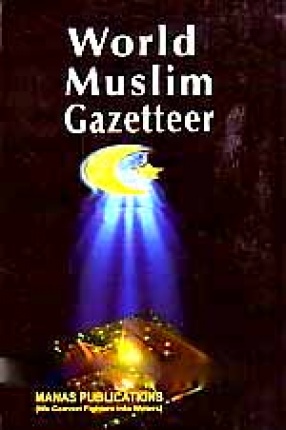The question of meaning in Tantric ritual is considered here on the evidence of the Saiva traditions of Kashmir. This evidence is principally that of an extensive corpus of learned Sanskrit works produced between AD 900 and 1300 to explain the systems of ritual and theology taught in the Tantric Saiva scriptures. But there is also the evidence of the more recent practice of the Kashmirians reflected in the anonymous manuals which record the text and procedure of their rituals. This second class of evidence, available partly in editions produced for local distribution and partly in unedited manuscripts, is of the kind that has generally been overlooked by Indology. This is particularly so in the case of the Saivism of Kashmir, where scholarly interest has concentrated on its metaphysical and mystical elements, and not at all, or with much less precision, on the ritual and social organization which are their substrate. When the prescription and theory of ritual have been neglected in the study of the learned works of the medieval period, it cannot be surprising that these humble manuals should have escaped attention altogether. However, once one has realized that it is necessary to approach the Saiva traditions of Kashmir from an understanding of their basis in ritual, then the importance of these materials becomes obvious. For they are almost our only evidence of Saivism in the region which is not a theoretical or prescriptive kind. They provide us with a background of reality against which to evaluate the implications of theory and to consider the degree and manner of the idealization of actual practice that we must expect in authoritative prescription. Unfortunately this body of evidence is itself inadequate in certains respects. One would be in a better position if more of this kind of text had survived: the record of real practice is far from complete. Furthermore, this anonymous literature cannot be dated before the modern and late medieval manuscripts in which it has come down to us. Therefore one cannot take for granted that the practice they record has continued unchanged from the times of our theoretical and prescriptive texts. It appears, however, that change has generally been in the form of contraction to essentials; and this, after all, is what one would expect in a dwindling community concerned to preserve its identity. From AD 1320 to 1819 Kashmir was under almost continuous Muslim rule and by the end of this time the great majority of the population, including many brahmins, had adopted Islam.
These sources certainly do not cover the whole of Tantric ritual. The rich Buddhist tradition of the Way of Mantras (Mantrayana, Vajrayana) is entirely overlooked, as is the Vaisnava Tantric tradition of the Pancaratra. Nor do they cover the whole of the complex and many-leveled Saiva tradition which is the rest and major part of Tantric Hinduism. They are nonetheless an excellent starting point for an enquiry such as this; for they encompass all the major strata of Tantric Saivism at the most vigorous and articulate phase of their development. Nor were these Kashmirian perspectives on the Saiva tradition of merely local importance. They became the standard of Tantric orthodoxy in southern India from the eleventh century and were widely disseminated from this base during the centuries of Kashmir’s decline from its position as a major centre of brahminical learning.
During the early medieval period Tantric Saivism in Kashmir was dominated by two competing traditions. On the one hand was the Trika and on the other the Saiva Siddhanta. The first adhered to a nondualistic theology according to which all phenomena are nothing but the spontaneous self-projection of an all-encompassing divine consciousness, so that the substance of the universe and its efficient cause are one and the same. This absolute idealism was formulated and defended by Somananda (fl. c. AD 900-950), Utpaladeva (fl. c. AD 925-75), and the latter’s commentator Abhinavagupta (fl. c. AD 975-1025). The principal works of this philosophical tradition came to be known as the Sastra of Recognition (Pratyabhijnasastra) after their central concept, namely that liberation comes about as the recognition (praiyabhijna) that the true identity of oneself and all phenomena is the Lord (isvarah) defined as this all-containing, autonomous consciousness. Their works of Tantric exegesis and those of their successors claimed that this nondualism is the doctrinal basis of all the scriptures which prescribe the Trika’s rituals and observances and those of certain related traditions.
The Saiva Siddhanta (henceforth Siddhanta), which the Trika’s non-dualism opposed, adhered to a strict dualistic theology (dvaitavadah, bhedavadah). It claimed that the highest Saiva scriptures are those which prescribe its own system of ritual and that they teach (i) that Siva as the omnipotent and omniscient efficient cause (nimittakaranam) of the universe is other than its matter (upadanam), the world (the sum of the evolutes of this matter) being entirely distinct from the consciousness of Siva and of all other souls, and (ii) that these other souls never lose their individual identity even in the state of final release (moksah). So separation (bhedah) — between souls, between souls and Siva, and between these and the external world — is real and absolute in the Siddhanta, while in the Trika it is merely apparent. By the same principle, liberation (moksah) in the Siddhanta is the attainment of mere equality with Siva (sivatulyata), while in the Trika it is recognition that one is Siva himself, that one’s individuality is an act staged by a transpersonal Absolute. Instead of becoming Siva one becomes independent from him by rising above the levels under his power. This dualistic theology was propagated in Kashmir on the basis of certain works by Sadyojyotih, an author of ncertain date who may or may not have been Kashmirian himself. For rigorous philosophical defence of this doctrine as well as for our most detailed dualistic exegesis of its scriptures we have the works of Bhatta Narayanakantha and his son Bhatta Ramakantha (fl. c. AD 950-1000). Outstanding are the former’s commentary on the Mrgendratantra and the latter’s commentaries on the Matangaparamevaragama and Sadyojyoti’s Narevarapariksa.
For the Trika this distinction between dualism and nondualism was also reflected in ritual and observance. The religious practice of the Siddhanta as dualistic (dvaitacarah) in the sense that it accepted the orthodox (Vedic) distinctions between the pure and the impure and remained strictly within the boundaries of the former. The Trika, by contrast, advocated the practice of nonduality (advaitacarah), in as much as its rituals involved contact with impure persons and/or substances. It justified this apparently impious transcendence of the norms of conduct by arguing that this practice of nonduality had been revealed by Siva himself in his highest and most esoteric scriptures as the ultimate means of liberating consciousness from the contraction (samkocah) or inhibition (sanka) holds it in bondage.
Since this orthopraxy and heteropraxy are characterized in our sources as right (daksina-) and left (vama-) respectively, where right is that which agrees with orthodox norms and left that which goes against them, I shall refer to the two schools as the Saivism of the right and the Saivism of the left. While the first expression will always be exactly synonymous with the term Siddhanta, the second will refer not only to the Trika but also to certain other non-Saiddhantika Saiva systems of ritual, most particularly the closely related Kali cult known as the Krama (Sequence), Mahanaya (Great Way) or Mahartha (Great Truth). Among the evidence for the Kashmirian Trika by far the most outstanding work, since it covers all aspects of the tradition, is Abhinavagupta’s monumental Illumination of the Tantras (Tantraloka), which has come down to us with the commentary (-viveka) of Jayaratha (fl. c. AD 1225-75). In the Kashmirian Krama the most complete and penetrating of our sources is undoubtedly the Elucidation of the Great Way (Mahanayaprakasa) by an unknown author concerning whose date we can say only that he knew the works of Utpaladeva (fl. c. AD 925-975) and was quoted by Jayaratha in the thirteenth century.
The Siddhanta, Trika and Krama were not the only major Saiva traditions in Kashmir. In addition there was that of the cult of an esoteric form of Siva and his female consort known as Svacchandabhairava and Aghorevasi. Indeed it was this cult which seems to have been the norm among the Kashmirian Saivas from the early medieval period down to modern times. However, unlike the Siddhanta and the Trika, it was not the source of any distinct theological position. During the tenth and eleventh centuries it had been largely colonized by the dualistic exegesis and practice of the right. Later the influence of the Siddhanta waned and the cult fell under the influence of the nondualistic doctrines of the left. This takeover of the middle ground was actively sought by the left as soon as it had achieved an articulate theology, that is to say, round the turn of the millenia. Ksemaraja (fl. c. AD 1000-1050), the successor of Abhinavagupta, composed a learned and detailed commentary on the Svacchandatantra, the scriptural authority of the cult, and tells us that he did so in order to displace the long established tradition of dualistic interpretation which, he claimed, had perverted the true character of this tradition.
Also in this middle ground between the Siddhanta and the Trika was the cult of Siva Conqueror of Death (Mrtyunjaya) — also called Netranatha (the Eye-Lord) and Amrtesvarabhairava (Bhairava, Lord of the Nectar [of Immortality]) — and his female consort Amrtalaksmi. Particularly associated with rites to avert danger and disease (santih), it appears in the recent manuals to have been closely linked with that of Svacchandabhairava. Here too dualistic exegesis prevailed before giving way to the ascendant nondualism of the Trika. And once again it was a commentary by Ksemaraja on its scriptural authority known variously as the Netratantra, the Mrtyujittantra and the Amrtesvaratantra, that initiated the transformation. These two commentaries by Ksemaraja, his Elucidations (-uddyota) of the Svacchandatantra (Svacchandatantroddyota)and the Netratantra (Netratantroddyota), are evidently of special importance to us, since they give us access at an early date to the middle ground of Kashmirian Saiva practice preserved in the manuals.








There are no reviews yet.